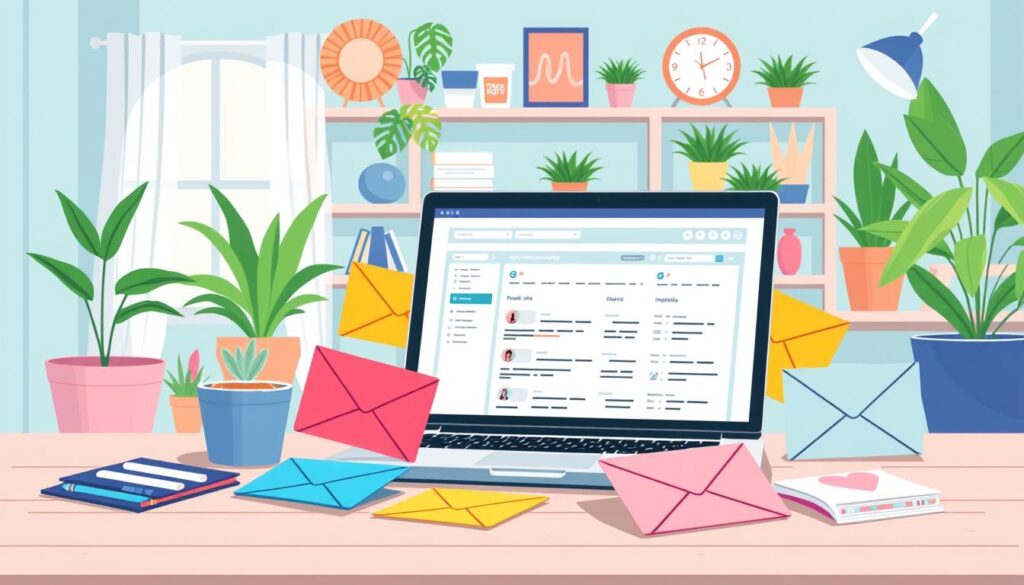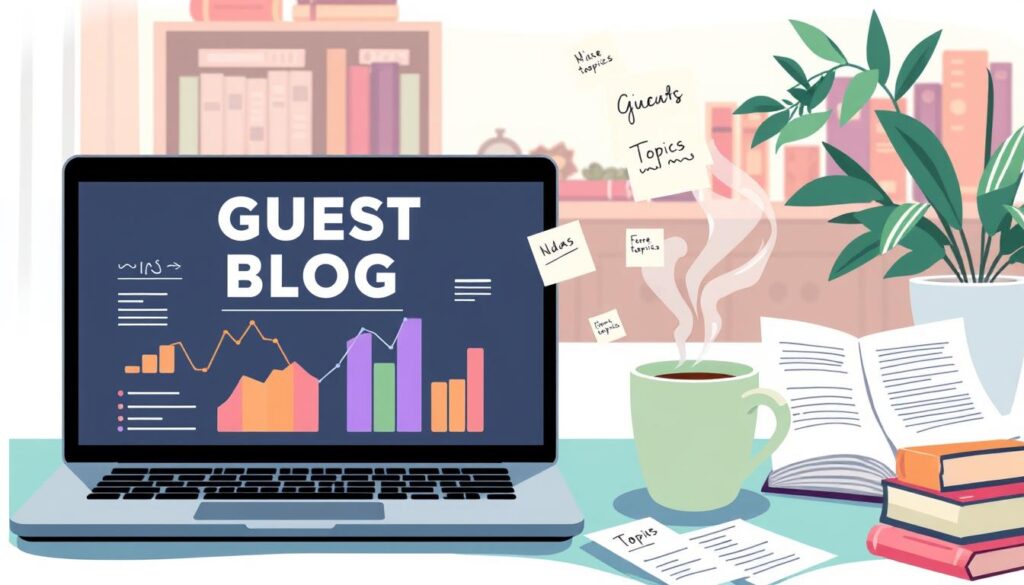When Emma first started her food blog, she was thrilled about its potential. She dreamed of sharing engaging content and building a loyal following. But soon, excitement turned to frustration. Even with her hard work and passion, her blog’s traffic was disappointingly low. She realized that having a blog was not enough; driving traffic to it was key.
Every new blogger faces this tough reality, just like Emma did. Through her journey, she learned vital strategies for growth. New blogs often have zero domain authority, making search engine recognition tough at first. Also, the “Google Sandbox period” might hide a blog for months.
Creating successful blog posts means 22% of content must deeply connect with readers. This proves that offering valuable, engaging content is crucial from the start. Also, targeting specific, relevant keywords can boost your blog’s visibility.
There are simple strategies to increase blog traffic for beginners. This guide will show you key methods that turned Emma’s blog from invisible to vibrant. From keyword tools to social media, we’ll share tactics for success.
Key Takeaways
- New blogs often struggle initially due to zero domain authority and the Google Sandbox period.
- Effective keyword research is crucial for targeting low-competition, high-conversion keywords.
- Quality content that answers audience queries can significantly improve engagement and retention.
- Leveraging various tools like Google Search Console is indispensable for tracking and growing blog traffic.
- Visual aids, such as images, can increase blog post views by up to 94%.
Create Great Content to Increase Blog Traffic
Success in blogging comes from high-quality content. This means knowing your audience well and using smart content marketing strategies. Let’s look at how content quality is key and how Google’s EEAT guidelines can help you make content that stands out.
Why Content Quality Matters
High-quality content is crucial for growing your blog. Think about a blog that went from 0 to 12,000 page views in three months. Then, it jumped to 100,000 in 18 months. This shows that great content can really boost your blog’s visibility and success.
Using blog traffic strategies wisely makes a big difference. For example, updating existing content can be more effective than creating new posts for well-established blogs. Google values fresh and relevant content, which is clear from updates to its search algorithms. Articles with the right keywords and optimizations tend to rank higher, helping more readers find your blog.
Implementing Google’s EEAT Principles
Google’s EEAT (Expertise, Authority, Trustworthiness) principles are key for good content. By focusing on these, you make sure your posts are not only useful but also trusted and seen as authoritative. This is what you need to attract more blog traffic.
- Expertise: Show you know your stuff. Detailed, well-researched posts boost your blog’s credibility and offer readers real value.
- Authority: Authority grows with time and effort. Interacting with readers and guest posting on related websites boosts your blog’s profile.
- Trustworthiness: Trustworthy content wins reader loyalty and prompts sharing. This includes being transparent and accurate, and keeping a respectful tone.
Following these guidelines has big rewards. For example, about 75% of users don’t go past the first search results page. That’s why SEO is so important. Adding images can increase views by 94%, and posts with videos get shared way more than those without. These facts show how mixing different types of media can make your blog more engaging and successful.
In conclusion, focusing on smart content marketing and strategies based on Google’s EEAT principles can really boost your blog’s growth. Quality and relevance are the foundations for building steady traffic and achieving long-term success.
Start with Keyword Research
Keyword research is vital for a successful blog. You can create engaging content by knowing what your audience searches for. This also helps your blog rank higher in search engines. Blogs with high traffic rank for multiple keywords, showing the value of keyword optimization.

Using Tools for Effective Keyword Planning
Using tools like SEMrush and Google Keyword Planner is key. They help find competitive and long-tail keywords. You get to know search volumes and keyword difficulties, which helps choose the right terms.
Placing focus keywords in the title, meta descriptions, and headings boosts SEO. Google Analytics and Google Search Console offer insights on popular posts. They reveal what readers like most over three months.
Finding Long-Tail Keywords
Long-tail keywords have less search volume but are easier to rank for. They draw in niche audiences, bringing relevant visitors. This strategy boosts organic traffic, engagement, and conversion rates.
Keyword research is a must for marketers to optimize sites. Organic traffic from search engines grows over time with little effort. Unlike social media traffic, which needs constant work. Focus on what your audience wants for better rankings and sustained growth.
In summary, effective blog SEO starts with consistent keyword research. Tools like Google Search Console help analyze important metrics. By finding the best keywords, you ensure a successful blog and grow your audience.
Write About Trending Topics
Writing about what’s hot right now is a top blogging tip for traffic growth. By focusing on current trends, you’ll likely reach more people. 59% of marketers say blog content is a key strategy to draw in traffic.
Tools like Google Trends and BuzzSumo show what’s trending in different areas. This makes it easier to find and write about topics your readers will love. 77% of internet users regularly read blogs, favoring content that’s up-to-date and relevant.
Blogs that talk about trending topics get more attention and new visitors. Using targeted keywords well can boost your traffic by 5-10%. Plus, adding visuals can lead to 94% more views than just text, highlighting the importance of engaging posts.
Here are a few handy tips for covering trending topics:
- Use Google Trends to find and write about new trends.
- Keep up with industry news for fresh content ideas.
- Use catchy headlines with numbers to get 36% more clicks.
- Add infographics to your posts for easy-to-understand, shareable content.
Staying current not only keeps your content interesting but also helps build a loyal audience. These blogging tips for traffic growth are great for increasing your blog’s visibility.
Optimize Your Blog Posts for SEO
Making your blog SEO-friendly is crucial for more traffic and better search engine rankings. Using on-page SEO strategies, understanding search intent, and finding long-tail keywords with AnswerThePublic can really boost your blog.

On-Page SEO Techniques
On-page SEO makes your web pages rank better. You need to work on title tags, meta descriptions, and headers to make them short and relevant. Since Google may cut off title tags over 70 characters, it’s important to keep them brief.
Adding keywords in your content naturally is vital. Internal links are also crucial as they help Google find new pages. This improves your website’s SEO.
- Use concise and relevant title tags and meta descriptions.
- Include keywords naturally within your content.
- Incorporate internal links for better navigation and PageRank distribution.
- Compress images to improve page load speeds, a known ranking factor.
Importance of Search Intent
Knowing search intent in SEO lets you match your content with what people are looking for. Search intents can be informational, navigational, or transactional. Matching the right intent with your content means users are more likely to find what they need, which improves engagement and lowers bounce rates. High bounce rates hurt SEO since Google looks at user interactions.
“Understanding and serving search intent means considering what users are expecting to find. This approach not only helps in creating more accurate content but also in driving higher engagement rates.”
Using AnswerThePublic for Long-Tail Keywords
AnswerThePublic is great for finding specific long-tail keywords. For instance, starting with “high quality backlinks” can lead to competing for broader terms like “backlinks” as your site gets more authority. Long-tail keywords might get fewer searches, but they bring in more focused traffic.
- Leverage AnswerThePublic to find long-tail keywords.
- Focus on specific queries to attract targeted readers.
- Monitor evolving keywords and update your content as your domain authority increases.
Leverage Social Media Promotion
In today’s world, social media is key to getting more eyes on your blogs. Billions use sites like Facebook, Instagram, LinkedIn, and X (once Twitter), and knowing how to use these can help your blog grow. Let’s dive into making the most of social media to promote blogs.
Promote Blog Posts on Multiple Platforms
Spreading the word about your blog on different social media sites is vital:
- Facebook: Use groups and pages to share your posts. Links in your posts can drive 1.5 times more people to visit.
- Instagram: Instagram Stories can have direct blog links, possibly upping visits by 500%.
- LinkedIn: A well-set LinkedIn profile could boost your traffic by 20-50%. Posting in LinkedIn groups gets you noticed by more people.
- X (Twitter): Tweeting your blog post links can get them to spread fast, pulling in readers. Hashtags help even more.
About 80% of marketers see more site visits through social media. Big follow buttons and widgets, like the Facebook like box, bump up conversions and visits.

Create Engaging Social Media Content
Making content that grabs people’s attention on social media is crucial for bringing them to your blog. Try these tips:
- Contests and Giveaways: These can spike engagement by 34%, greatly increasing clicks.
- User-Generated Content (UGC): Get followers to share their stories tied to your topics. UGC heavily influences buying choices and ups traffic.
- Influencer Partnerships: Working with influencers can yield an 11 times higher ROI than other online marketing, driving visits to your blog.
- Regular Engagement: Consistently interacting boosts website traffic 4-7 times, improving growth and interaction.
Also, putting your blog URL on your social media can up referral traffic by 32%. Using a link tree is smart for platforms like Instagram, where link options are limited.
Mastering social media for blogs and making engaging online content can draw in more readers and greatly increase your blog’s visits.
Repurpose Content for Different Platforms
Repurposing content increases its reach and lifespan. It’s key for bloggers. Different platforms draw different people. By adapting your content, your blog’s traffic will grow. Imagine turning a blog post into a YouTube video or an infographic. Let’s explore how to do this well.

Turning Blog Posts into YouTube Videos
Turning your blog posts into YouTube videos is a great strategy. YouTube brings in viewers who prefer videos over reading. Here’s how to start:
- Identify Key Points: Pick out the main ideas from your blog to show in your video.
- Script Writing: Turn these points into a script that’s easy and informative.
- Visual Creation: Make visuals using screen recording or slides that go with your script.
- Video Editing: Edit your video with tools like Adobe Premiere Pro, adding cool effects and music.
- SEO Optimization: Make sure to use keywords in your video’s title and description for better visibility.
Creating Infographics
Creating infographics works well too. People love sharing visual content. Here’s turning written content into infographics:
- Summarize Data: Pick out important stats and facts from your blog.
- Choose a Layout: Find a layout that shows your data well. Canva and Piktochart have lots of templates.
- Design Elements: Use your blog’s colors and graphics in your infographic.
- Visual Hierarchy: Layout your infographic so it’s easy to follow.
- Share Widely: Share your infographic on social media and other places to get it seen by more people.
Using these repurposing strategies will attract new readers from various sources. This expands your blog’s audience. Remember, tailoring your content for different platforms is smart. It boosts engagement and reach over time.
Build an Email List for Direct Marketing
Building an email list is key to growing your blog audience. It lets bloggers share content, promote products, and connect with readers directly. Email marketing brings back $44 for every $1 spent, showing its power.

The Importance of Email Newsletters
Engaged subscribers are very valuable. Businesses that email only those who opt-in see fewer people unsubscribe. Personalized emails can greatly increase conversions by 30-50%. Seasonal campaigns can boost this even more, by up to 40%.
Sending too many irrelevant emails may cause more unsubscribes. So, it’s important to group email lists by interests or past actions. Using bought email lists often leads to high bounce rates. Organic growth is best for real engagement.
Using Email Marketing Tools
There are tools that help manage email campaigns and grow your list. Platforms like MailChimp and Constant Contact have great features. They offer list segmentation, tracking, and ways to test what works best. Adding opt-in forms on busy pages can really help increase sign-ups.
- MailChimp: Offers automation and advanced analytics to track campaign performance.
- Constant Contact: Known for its easy-to-use interface and excellent customer support.
- ConvertKit: Ideal for bloggers looking for simple yet effective email marketing tools.
Pop-up forms are effective for getting email addresses. Personalizing these pop-ups by location can make sign-ups even more successful. A well-cared-for email list can be a big source of income. People like content that feels made just for them.
Good lead generation keeps readers coming back and engaged. This means stronger connections with your readers, which helps your blog succeed long-term.
Engage with Your Audience Through Comments
Connecting with your blog audience is key to creating a loyal community. One top way is through comments in reader interaction techniques. About 7.5 million blog posts are published daily. Engaging well can make your blog shine. Here’s how to encourage comments effectively.

To get more comments, ask an open question at the end of every post. This invites replies and shows you care about what readers think. Also, quickly reply to comments. This starts conversations and keeps your audience engaged for longer periods.
Feedback is great for making your content better. It shows readers you value their thoughts. It also improves your blog’s readability and relevance.
Since mobile devices bring about 63.38% of web traffic, make commenting easy on phones. Good mobile interaction can boost engagement.
Active comments do more than boost reader interaction; they help with SEO. Blogs with lively discussions often rank higher, leading to more organic traffic. This keeps your blog prominent, attracting ads and affiliate marketing deals.
Last, comments build a community, leading to more shares and subscribers. This broadens your blog’s reach. Using these reader interaction techniques can turn casual readers into dedicated fans.
Guest Blog on Niche Websites
Guest blogging is a great way to reach more people and attract targeted, high-quality traffic. By sharing valuable content on popular blogs in your niche, you can get noticed by their readers. Good guest blogging tactics can make you a recognized authority and bring new readers your way.

Finding Relevant Blogs for Guest Posting
It’s important to pick the right blogs for your guest posts. Look for ones that have a big audience and high domain authority. This helps to bring more focused traffic to your site. Tools like SEMrush, Ahrefs, and Moz are helpful for finding blogs with strong domain metrics. Also, using LinkedIn and other professional networks can reveal opportunities for guest posts.
Before choosing a blog, think about:
- The audience’s demographics and interests
- How active the blog is (like comments and shares)
- If the blog’s usual content matches your expertise
Benefits of Targeted Traffic
Targeted traffic from guest blogging has many advantages. You can see more visitors and better conversion rates because the audience is more aligned with your content. Effective guest blogging can also increase your blog’s visibility and credibility. Research shows that detailed, quality guest posts lead to more engagement and shares, bringing more people to your site.
Look at these success stories:
A guest post with expert insights got thousands of shares and about 5,000 visits in a few days. Plus, a reshared post on Tweak Your Biz received over 2,500 social shares and attracted more than 21,000 visitors.
These stories highlight how powerful properly done guest blogging can be. It’s a key strategy for boosting your blog’s traffic.
Drive Traffic with Pinterest
Using Pinterest can bring lots of visitors to your blog. With over 2 billion searches each month, bloggers should use it for more visibility.
Creating Pinterest-Worthy Images
Images must look great on Pinterest to get more blog traffic. Making viral pins is key. Pins need to be high-quality and look professional to engage people. Pins that have 200 characters in their descriptions get shared the most.
Use colors like red, orange, or pink, because they get noticed more. Bright images work 20 times better than dark ones. The best size for Pinterest images is 2:3 or 4:5. Bigger pins get more attention. Helpful pins get 30% more engagement, which helps them go viral.

Using Pinterest Boards Effectively
Putting your posts into well-organized boards helps get traffic from Pinterest. Creating 3-5 pins per blog post is advised to get seen more. Spread out when you add new pins to reach more people. Use Pinterest analytics to see which pins work best. Despite changes, group boards are still useful for finding new followers. Adding Pinterest’s “Pin It” widget on your site helps too. It lets people pin your content directly, increasing traffic.
Pins spread more than tweets, being 100 times more shareable. Each pin can lead to 2 site visits and 6 pageviews. Because pins last longer than other social media posts, regularly creating viral pins helps a lot in the long run.
Collaborate with Influencers
Using influencers can greatly improve your blog’s visibility and trustworthiness. Partnering with micro-influencers, who have 1,000 to 100,000 followers, is very effective. They have a strong connection with their audience, making them more relatable. Here are some steps to find and partner with these influencers successfully.
Identifying Micro-Influencers in Your Niche
It’s crucial to find the right micro-influencers for your blog. Start by exploring your niche for relevant influencers. Use platforms like Instagram, Twitter, and YouTube to start your search. Look for influencers whose engagement rates match what you need. For example, someone with 30,000 followers and 5,000 engagements shows a 17% rate. This means they interact a lot with their audience. Tools like BuzzSumo or Influence.co are also helpful. They offer useful metrics and profiles to make your search easier.
Building Mutually Beneficial Partnerships
When you find potential partners, work on building a good relationship. Success in influencer marketing is built on authenticity. Start by being open and clear. Set clear goals and ways to measure the campaign’s success. Transparent conversations about expectations, like more visibility or followers, are crucial. Using giveaways, discount codes, or unique content can make these partnerships even better. Working with the right influencers can be very rewarding, sometimes giving back 19 times what you invest.
In summary, teaming up with micro-influencers is smart. By picking the right ones and forming strong partnerships, your blog can grow significantly. This can lead to a 50% increase in web traffic on average.
Utilize User-Generated Content
User-generated content for blogs has great benefits. It boosts authenticity, increases engagement, and drives lots of traffic. With 88% of consumers saying authenticity is key in choosing brands, it’s clear why brands love user-generated content. It makes their posts more real and relatable.
Using user-generated content can change the game. For instance, including customer reviews boosts engagement by up to 90%. People trust content from other consumers more than traditional ads—92% do. This trust leads to a big jump in conversion rates, by as much as 29%.

Add gamification to your user-generated content strategies to make interactions soar. This approach can boost user involvement by 50%. Plus, campaigns with user content see a 50% higher click-through rate than standard ones. This proves the unique appeal of genuine content.
Try hosting contests or asking for community input to get more user-generated content for your blogs. Look at the Barbie Selfie campaign. It was used over 13 million times in just four months. Getting users to share their stories can boost site returns by 20% and build community spirit.
To wrap up, adding user-generated content to your blog can really up engagement. It helps build a community and creates real connections with users. User-generated content matters a lot—it affects 79% of buying decisions and can triple conversion rates. So, it’s a key tactic for staying ahead in content marketing.
Create Learning Hubs or Resource Pages
Creating learning hubs increases visitor engagement. It drives organic traffic to your blog. These organized hubs are a central repository of information. They give great value to users, making their experience better. Using resource page strategies improves usability and SEO efforts.
Organizing Content into Sections
To create effective learning hubs, organize your content well. This means:
- Subtopic Grouping: Divide your main topic into related subtopics. This ensures you cover the topic fully.
- SEO-Friendly Structure: Your sections should match key search intents. Include important keywords in a natural way.
- User Navigation: Make your hub easy to navigate. Users should find what they need without trouble.
Linking to Both Internal and External Resources
Using both internal and external links is key to resource pages. Here’s why:
- Internal Linking: Smoothly guide users across your site. This increases page views and time spent on your site. Long articles offer many chances for internal links, improving user experience.
- External Linking: Linking to trusted external sources builds authority. It can also attract backlinks. High-quality backlinks boost your blog’s visibility significantly.
A great example is the learning hub by Drift on Chatbots. It got over 500 unique website links. It brought about 6,000 monthly search visits in just seven months. Follow these strategies to create learning hubs. They will engage users and bring more traffic to your blog.
Comment on Related Blogs
Commenting on other bloggers’ posts is a great way to bring people to your blog. When you leave thoughtful and helpful comments, you show your knowledge. It also makes you a key part of the blogging community. This helps you connect better through comments on blogs.
Good commenting strategies include:
- Choosing blogs that fit your interests.
- Reading the blog post fully before you comment.
- Adding insightful thoughts to deepen the conversation.
For example, consider the Humane Society of the United States. Their blog ranks for thousands of keywords and gets around 36,000 visits each month. By engaging with popular blogs, you can get more people to visit your site.
Blog commenting can bring in around 50 new visitors for each comment. With the right approach, these new visitors might stick around, boosting your blog’s engagement and subscriber count.
Think about leaving comments on the top 25 blogging blogs. This can lead to 100 to 1,000 additional visitors every day. Comments at the top of the discussion are even more powerful. They can bring in about 19 interested visitors per comment. These visitors typically stay for four minutes.
Using commenting strategies well can greatly increase your blog’s visitors. It helps make your site more visible. Plus, it builds a strong online community through smart networking and comments.
Driving Traffic to Your Blog: Beginner Strategies
Starting a blog is both exciting and tough, especially about driving traffic. Most websites don’t get traffic from Google. It’s vital to use effective strategies early on. Here, we’ll cover basic techniques to promote your blog and boost traffic easily. Let’s jump in!
Creating Great Content: Quality content is key for a successful blog. Stick to Google’s E-E-A-T principles to make your blog shine. Focus on evergreen content, as it stays relevant over time.
Keyword Research: Begin with in-depth keyword research, focusing on long-tail keywords. Tools like SEMrush and AnswerThePublic are very helpful. Aiming for long-tail keywords for a year can boost your blog’s visibility.
SEO Optimization: Optimize your posts with on-page SEO techniques. Your content should match what users are searching for. Use internal links to spread page authority and increase visits.
Publishing Frequency: Try to publish 1-2 posts each week. Aim for 1200 words to attract more readers.
Social Media Promotion: Promote your blog on social media. Join niche groups and interact. For example, one blogger expanded their Facebook group to over 8,700 members. It shows the strength of social media in forming communities.
Repurposing Content: Turn your blog posts into different formats. Make YouTube videos or infographics for Pinterest from your posts. Effective use of Pinterest boards can draw more people.
Building an Email List: Keeping visitors returning is crucial. Studies show 70% of visitors don’t come back. Newsletters and email marketing can engage your audience and encourage returns.
Guest Blogging and Collaborations: Guest posting on related websites can bring targeted visitors. Partnering with other bloggers expands your reach and can lead to shared promotions.
Engaging with Your Audience: Talk with your readers through comments on your and other relevant blogs. Real conversations can increase your traffic and help build a community around your blog.
Using these beginner tactics will lay a strong foundation for success. It often takes 5-6 months to see organic traffic growth. Yet, with dedication and the right approach, your blog will grow.
Learn more ways to attract readers and boost your blog traffic.
Monitor and Analyze Your Traffic
In 2023, blogging grows more popular each day. Knowing how to monitor blog performance is key for success. Google Analytics makes blog traffic analysis easy. This lets bloggers make smart choices. By looking at key metrics, you learn what content works best.
Keep an eye on page views to see how many times people visit your blog. Unique visits show how big your audience is. Referral traffic comes from social media or other websites. It’s important to know your bounce rate too. This shows if people stay or leave quickly. And don’t forget about organic traffic. It shows if your SEO efforts are working.
Google Analytics is a free tool that tracks all these metrics easily. It’s great for seeing page views, visitors, how long people stay, and who they are. Other tools like MonsterInsights and JetPack add more features. Checking these metrics every month helps you make your blog better. It helps you see the difference between organic and referral traffic.
Analyzing these metrics often helps bloggers keep getting better. For example, a high bounce rate could mean your content isn’t engaging enough. Or seeing many return visitors means people like your content. Learning blog traffic analysis helps you get more traffic. And it helps your blog keep growing.
Related Articles:
- How to Write Your First Blog Post
Craft posts that naturally attract readers to your blog. - Step-by-Step: How to Monetize Your Blog for Passive Income
Drive traffic that converts into income for your blog. - 7 Blogging Mistakes New Bloggers Make and How to Fix Them
Avoid traffic pitfalls and grow your audience with ease.








